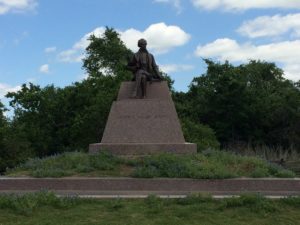
A statue of Stephen F. Austin marks the site of his settlement, San Felipe de Austin (Kathy M. Slaughter photo).
San Felipe de Austin is among the most historically significant sites in Texas. Located just north of Interstate 10 between Sealy and Brookshire, it is where Stephen F. Austin, in the 1820s, brought families of Anglo-American colonists to settle in what was then Mexico.
At one time, San Felipe de Austin ranked second only to San Antonio in terms of population. Cities such as Houston, Dallas, Austin, and Fort Worth didn’t exist then.
Stephen F. Austin led the colonizing efforts, but was not the only San Felipe resident who went on to a place in the Texas history books. Another resident, William B. Travis, became one of the commanders at the Alamo. He was living in San Felipe when he went west to meet his fate.
When the Alamo fell in March 1836, the Texas Army retreated eastward, towards the Sabine River, the border with the United States. When the Texans reached San Felipe de Austin, they realized that the advancing Mexicans would likely loot and destroy the town. They decided to prevent that by burning the town themselves as part of what became known as the Runaway Scrape.
Texas won its independence in April 1836, but San Felipe de Austin never recovered and was in danger of being forgotten. It wasn’t iconic as other sites such as the Alamo, or Goliad, or the San Jacinto Battleground.
Last week, the Texas Historical Commission, working with local officials and private donors, opened a new 10,000-square-foot interpretative museum across from the site. It provides a great opportunity for people to stop and learn.
The museum shares the story of Stephen F. Austin and the settlers he brought to Texas. It includes exhibits and a replica log cabin to help visitors better understand the people, the events, and the place. Additional markers behind the building illustrate key points in the town site.
When the museum was designed and built, planners understood the importance of technology for today’s audiences. The museum houses multimedia exhibits, including a large touchscreen wall mural that depicts the town layout as it appeared in the 1830s.
The museum sits directly across from the historic site on FM 1458. Like the historic site itself, the museum is definitely worth your time. For more information, see the web site, visitsanfelipedeaustin.com.
